-
Content Count
225 -
Joined
-
Last visited
Posts posted by rapid
-
-
Hi Geoffd,
Welcome to the forum where you'll find lots of useful information.
What you're trying to accomplish won't work using your TV. The F connector on the TV is intended for cablevision as the input is looking for a radio frequency modulated signal. Your camera produces an unmodulated signal.
A modulator, as you've discovered, is an option which will take the output of your Panasonic camera and convert it (or modulate it) onto channel 3 or 4 so you can view it on your TV. There is an easier option....
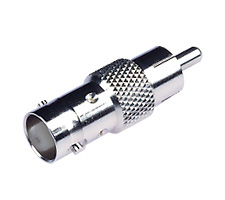

You can purchase one of these BNC to RCA adaptors from any audio visual store, and plug it into the back of your TV or VCR's yellow RCA video input jack. You'll need to replace the F connector on the cable with another BNC connector and plug it into this adaptor.
Voila!
-
one of my buddies sent it to me.....don't know where he got it.
If it is real....yikes!
-
Cost of tye rap...........5 cents
Cost of labeller............$50
Service Charge for video maintenance.......$100/hour
Arriving to find this.........Priceless!
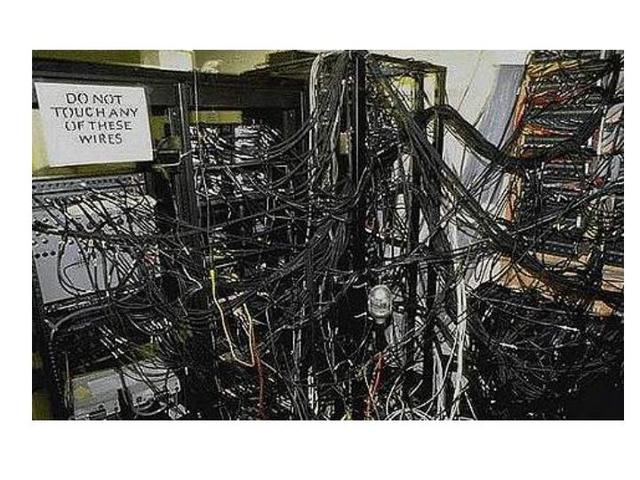
PS.....not my install
-
-
Depending on the lens design, you may have distortion around the edges of the picture. As well, it may produce a darker picture. I've seen some produce a "barrel" look if you use a smaller lens format.
Ensure the lens format is equal or greater than CCD format.
-
Did an office job this week with metal studs and no insulation (interior walls).

This is the Wet Noodle and retriever from Labor Saving Devices....the chain is 10 feet long and works great with a bendable magnetic retriever.
Had it in my install kit for awhile but never used it as most of the jobs have insulation or other material you have to fish through.
-
Lou,
Just PM'd some info to you and now my brain hurts
-
Loop thru switchers loop the inputs, ie the output isn't an output (sometimes written as OUT) but a terminated input.
So yes, I 've seen this before....you were probably seeing a double termination.
-
The 3 channel modulator and DVR would need to be in the basement or wherever your cablevision (cable in) enters your residence.
This is where your cameras will merge with the cablevision and supply your cameras on different channels to your upstairs TV's.
-
I think he means "straight for" or as we say "as the crow flies"
Have to admit in my early days (doing this for 18 years) I made a few poor judgements in cable pulling....all in all to get the job done.....then again I didn't have much training.
Ever pull cable just to find out you've looped it around a utility?....Guilty!
Course I'll never do that again.....yah right!
-
I'm surprised you can't find them locally?
Perhaps some of the guys from UK can help you.
No more VHS tapes!....is this the end of analog?
-
Thought you might like this one.....called the CableCaster Wire Pulling Tool..."The CableCaster is supplied with 3 darts and can launch a dart 15.25Mtrs or 50 feet." ONLY £52.00
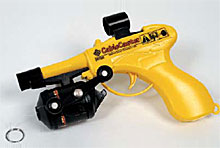
Note to self....don't bring this on a plane!
-
Ya, the "J" hooks are very handy if you have them.
On new installs, we work (and I use this loosely) with the IT guys and use cable trays for our cabling which makes things go well....plus it's easier to pull additional cables at a later date.
In the past you could pinpoint video cable, leaving it susceptible to tampering if it wasn't in conduit. Now that it's in the same tray as the IT group, no one is likely to cut anything in fear they might lose their internet!
-
If you're handy, you can create one of these by purchasing an extension cord caddy and removing the cable. The center portion is a flip open cover which exposes the other end of the connector when you fully extend the cable (leave a small loop of cable inside tied off to the reel), or you can panel mount a female BNC and power terminal block on the cover.
FYI....you might not get 150 feet of siamese cable in one of these caddys as they typically hold 25meters (80 feet) of extension cord.
-
Good suggestion on the Gopher Pole...hadn't seen this before. Although it's a bit pricey ($200 Cdn) looks like it would do the trick.

-
-
I hear you brother....
It was snowing here yesterday as well, but ended up being just a teaser.....guess I should finish some of those outdoor jobs I've been saving for a "rainy day"
Hopefully you can sit back on the weekend and have a few pops to relax.
-
-
As per my other thread, the Glo rods are good as well.
Once again, these are cheap DIY options instead of having to buy the fancy stuff
-
-
This method helps out on certain installs where you have the realestate above the ceiling tile, but I agree with you both for crowded areas.
As an alternative, I use the following Creep-Zit from Labour Saving Devices.
Each fluorescent 6 foot fiberglass piece has screw-on couplers, so you add the links as far as you want. The egg beater looking piece helps keep the rods from getting stuck on the ceiling tile supports. The fluorescent color makes it easier to see and retrieve in crowded spaces.

-
-
Well, here goes.....
For the last year, I've been compiling a list of "Tricks of the Trade" when installing video and alarm systems and think this would be the best time to share them with you members.
Hey...if there is a contest to be entered.....what an excellent time.
This is the first of five posts and all of these "tricks" I have used.
And remember, "You can try this at home!"
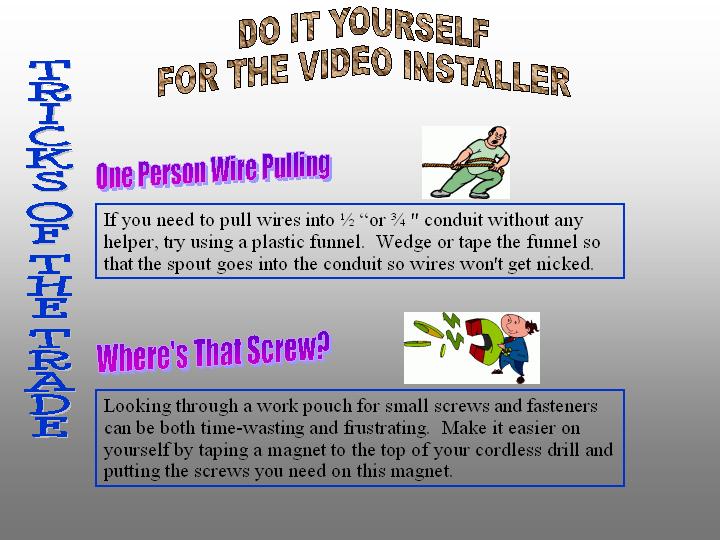
-
Welcome Ramonxie!
Enjoy your time at the forum.
Don't be afraid to ask questions.




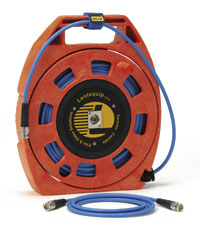
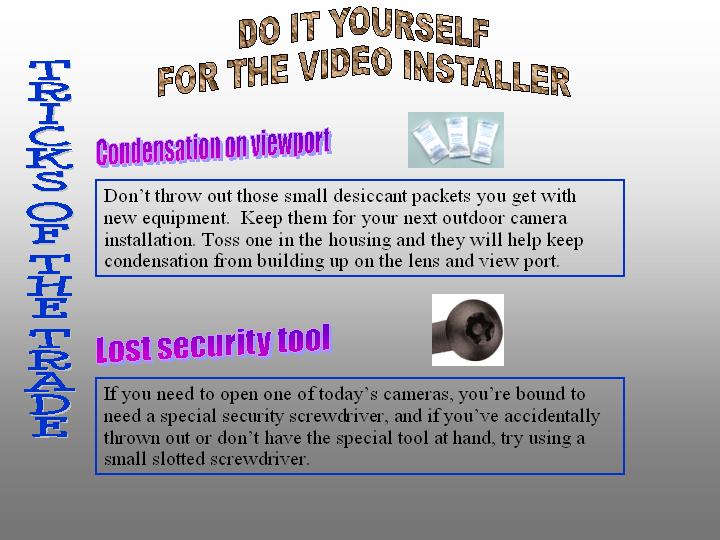
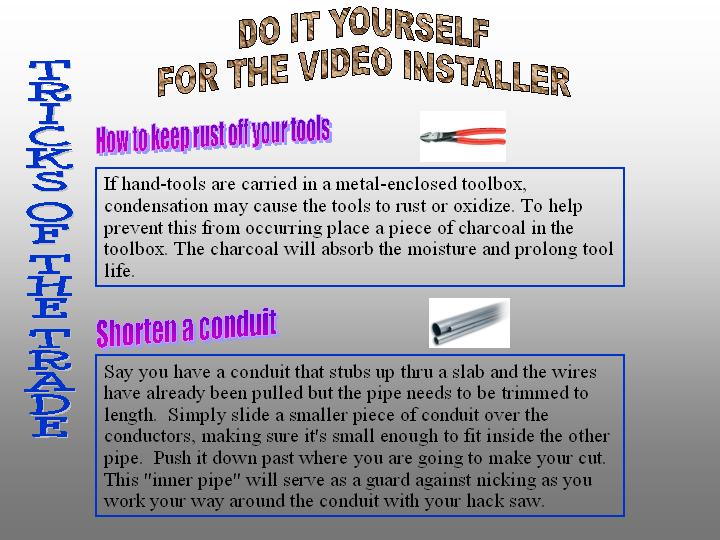
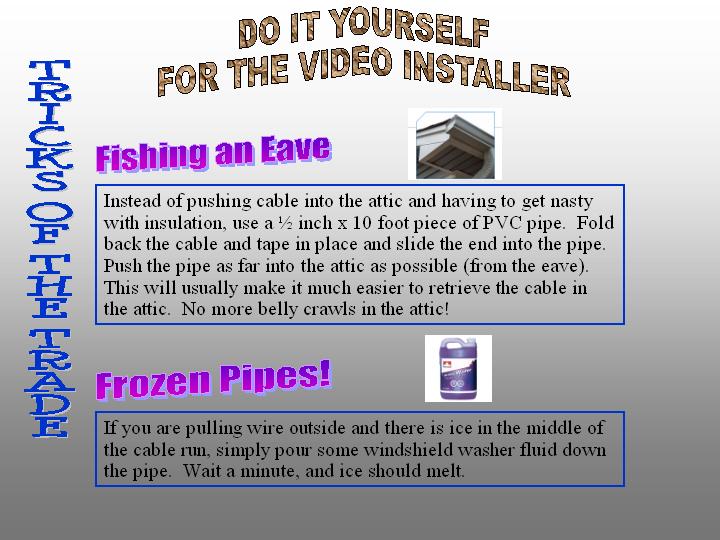
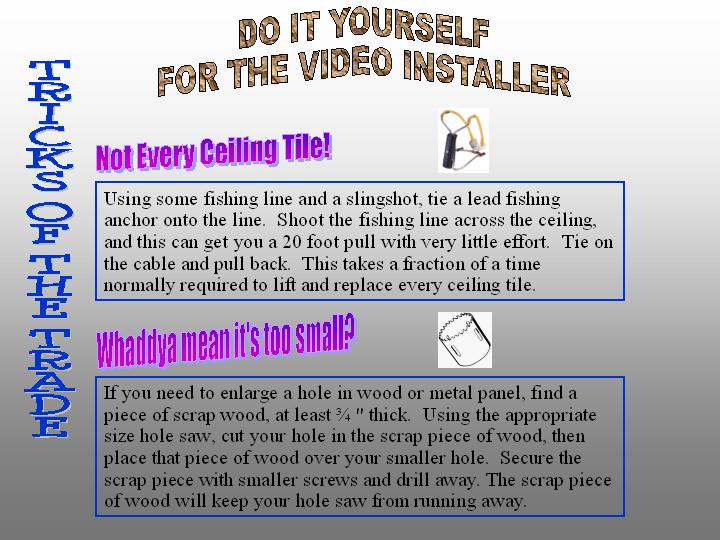
Long Range Wireless Survellance System for Police Use
in System Design
Posted
Reality check......but you're not going to find any one company who can provide a turn-key solution. Your application is unique, but sounds like a border type environment where you want to see an object far away, control the camera, record the signal, plus send the signal/control to another site.....all this with solar power or no local power?
Companies such as http://www.videotransmitters.com/ can provide you with low power video solutions with telemetry for the distance you mentioned. With 4 channels and some installs without line of sight, you will have a challenge.
As well, with wireless video links with telemetry, and high powered zoom lens, you will experience lag in telemetry transmission and never achieve zooming in to your target......(ie you're zoomed in...tilt the camera up and you miss the target....tilt down and you miss it again. I've done this before, so this is what you'll experience. Look for a proportional/variable speed pan/tilt so you can reduce this.
I know this doesn't help you much, but there are many factors like this to consider when going wireless.
Good Luck and hope you find answers.